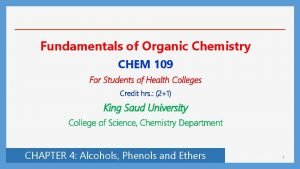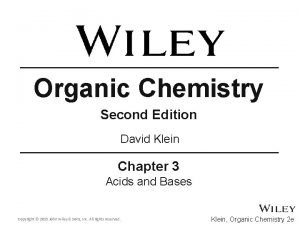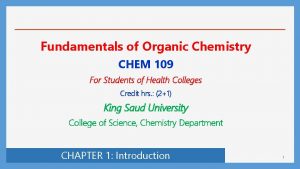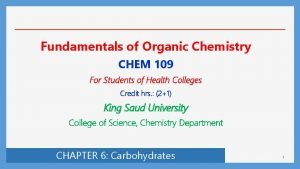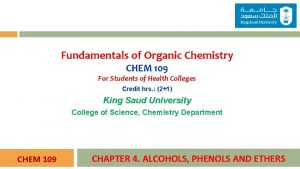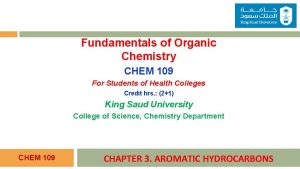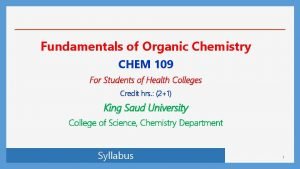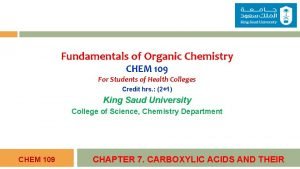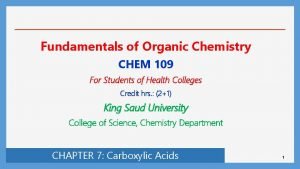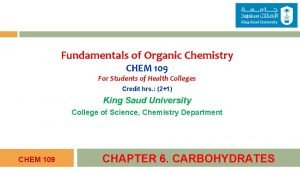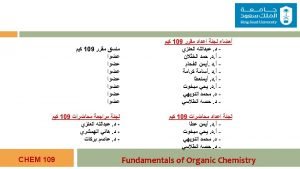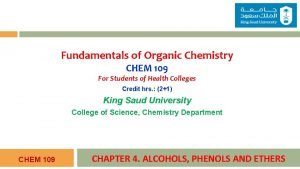Fundamentals of Organic Chemistry CHEM 109 For Students





















- Slides: 21

Fundamentals of Organic Chemistry CHEM 109 For Students of Health Colleges Credit hrs. : (2+1) King Saud University College of Science, Chemistry Department CHEM 109 CHAPTER 9. AMINO ACIDS, PEPTIDES AND

Learning Objectives At the end of this chapter, students will able to: q Predict the different type of amino acids. q Recognize the basic properties (structure, physical and chemical properties) of amino acids. q Predict whether the acid and amine groups in amino acids will be protonated at different p. H values q know how to prepare amino acids. q Describe the primary, secondary, tertiary and quaternary structure of proteins

3 Sources, Classification and Structure of Amino Acids o Proteins are naturally occurring polymers (polypeptides) composed of -amino acids units joined one to another by amide (or peptide) bonds. Example, animal hair and muscle, egg whites, and hemoglobin are all proteins. o Peptides are oligomers of amino acids that play important roles in many biological processes. Example, the peptide hormone insulin controls our blood sugar levels. o Peptides are classified to dipeptides, tripeptides, tetrapeptides, etc. . According to the number of amino acids in the chain. o Proteins, peptides, and amino acids are essential to the structure,

3 Sources, Classification and Structure of Amino Acids o The amino acids obtained from protein hydrolysis are -amino acids. o The amino group is on the -carbon atom, the one adjacent to the carboxyl group. o With the exception of glycine, where R = H, a-amino acids have a stereogenic center (chiral carbon) at the -carbon. o All except glycine are therefore optically active. o All natural amino acids L-configuration relative to glyceraldehyde. o Note that the Fischer convention, used with carbohydrates, is also applied to amino acids.

4 Sources, Classification and Structure of Amino Acids

5 Sources, Classification and Structure of Amino Acids List of the 20 -amino acids commonly found in proteins.

6 Sources, Classification and Structure of Amino Acids

7 Sources, Classification and Structure of Amino Acids

8 Sources, Classification and Structure of Amino Acids o The amino acids are known by common names. o Each also has a three-letter abbreviation based on this name, which is used when writing the formulas of peptides, and a one-letter abbreviation used to describe the amino acid sequence in a protein. For example; Glycine= Gly; Alanine = Ala; Valine = Val, etc. . o The amino acids are classified into: - Essential amino acids Eight amino cannot be synthesized by adult humans and therefore must be included in the diet in the form of proteins. e. g. Valine, Leucine, Isoleucine, Threonine, Methionine, Phenylalanine, Tryptophan, and Lysine. - Non-essential amino acids Twelve amino acids can be synthesized in the body from other foods. e. g. Glycine, Alanine, Serine, Cysteine, Proline, Tyrosine, Aspartic acid, Glutamic

Sources, Classification and Structure of Amino Acids Classification - Amino acids are classified on the basis of the structure of R q Aliphatic side chains non-polar amino acids: such as Alanine, Valine, Leucine, etc …. . hydrophobic q Polar side chains: are containing HO-, SH- and amide groups, such as Serine, Cystein ----hydrophilic q Acidic: are containing more than one COOH group, such as Aspartic, Glutamic------hydrophilic q Basic: are containing more than one N atom, Such as Lysine, Arginine-----hydrophilic q Heterocyclic/Aromatic – Such as Histidine----hydrophilic or hydrophobic

Sources, Classification and Structure of Amino Acids Aliphatic side chains – hydrophobic Polar side chains – text classifies as HO-, S-, and amide containing – hydrophilic

Sources, Classification and Structure of Amino Acids Acidic – hydrophilic Heterocyclic/Aromatic – hydrophilic or hydrophobic Basic – hydrophilic

Acid–Base Properties of Amino Acids 10 o Amino acids are classified according to the side chain into: i) Neutral amino acids, such as Glycine, Alanine, Valine, etc. . ii) Basic amino acids, such as Arginine, Lysine (they have extra amino group) iii) Acidic amino acid, such as Aspartic and Glutamice (they have extra carboxylic group) o Acid–Base Properties ▫ Since amino acids have both an acidic functionality and a basic functionality, we should expect the following equilibrium: ▫ In fact, the equilibrium lies to the right all amino acids are charged at any p. H! ▫ Such species that are overall neutral molecules but contain charged ends are called zwitterions

Acid–Base Properties of Amino Acids 11 o The amino group is protonated and present as an ammonium ion, whereas the carboxyl group has lost its proton and is present as a carboxylate anion. o This dipolar structure is consistent with the salt-like properties of amino acids, which have rather high melting points and relatively low solubility in organic solvents. o Amino acids are amphoteric. They can behave as acids and donate a proton to a strong base, or they can behave as bases and accept a proton from a strong acid. o The isoelectric point (p. I), the amino acid will be dipolar and have a net

Synthesis of Amino Acids 12 Strecker Synthesis: Recall reductive amination and Cyanohydrin formation.

2) Formation of an amide linkage (The peptide bond: 14 Reactions of Amino Acids Proteins) o Amino acids are linked in peptides and proteins by an amide bond (peptide bond) between the carboxyl group of one amino acid and the -amino group of another amino acid. o A molecule containing only two amino acids (the shorthand aa is used for amino acid) joined in this way is a dipeptide: o By convention, the peptide bond is written with the amino acid having a free +NH 3 group at the left and the amino acid with a free CO 2 - group at the right. o These amino acids are called, respectively, the N-terminal amino acid

2) Formation of an amide linkage (The peptide bond: 15 Reactions of Amino Acids Proteins) o We often write the formulas for peptides in a kind of shorthand by simply linking the three-letter abbreviations for each amino acid, starting with the N-terminal one at the left. o For example; glycylalanine is Gly—Ala, and alanylglycine is Ala—Gly. A tetrapeptide glycylserylphenylalanylglycine = gly-ser-phe-

The peptide bond: Proteins The Peptide (Amide) Bond The amide nitrogen is sp 2 hybridized and the lone pair is conjugated with the carbonyl group There is considerable C–N double-bond character Rotation about the C–N bond is difficult

Structure of Proteins 16 o Proteins are biopolymers composed of many amino acids connected to one another through amide (peptide) bonds. o Some proteins are major components of structural tissue (muscle, skin, nails, and hair). o Others transport molecules from one part of a living system to another. o The main features of peptide and protein structure. - Primary structure; How many amino acids are present and what their sequence is in the peptide or protein chain. - Secondary, tertiary, and quaternary structures; Three-dimensional aspects of peptide and protein structure, usually referred to as their.

he Primary Structure of Proteins 17 o The backbone of proteins is a repeating sequence of one nitrogen and two carbon atoms. o Peptides and proteins can be hydrolyzed to their amino acid components by heating with 6 M HCl. o An instrument called an amino acid analyzer is used to determine the amino acids mixture.

Uses of Amino Acids o Amino acids, often referred to as the building blocks of proteins, are compounds that play many critical roles in your body. o They're needed for vital processes like the building of proteins and synthesis of hormones and neurotransmitters. o Phenylalanine plays an integral role in the structure and function of proteins and enzymes and the production of other amino acids. o Valine helps stimulate muscle growth and regeneration and is involved in energy production. o Leucine helps to regulate blood sugar levels, stimulates wound healing and produces growth hormones.
 Chem 109
Chem 109 Ib organic chemistry functional groups
Ib organic chemistry functional groups Organic vs inorganic chemistry
Organic vs inorganic chemistry Meth eth prop but pent hex hept oct non dec
Meth eth prop but pent hex hept oct non dec Ario acidity
Ario acidity Cycloalkanes
Cycloalkanes Canola oil
Canola oil Ester organic chemistry
Ester organic chemistry Structural formula vs displayed formula
Structural formula vs displayed formula Rearranged most stable carbocation is
Rearranged most stable carbocation is Ee organic chemistry
Ee organic chemistry Ario organic chemistry
Ario organic chemistry Thermodynamic vs kinetic control
Thermodynamic vs kinetic control Organic chemistry david klein 3rd edition
Organic chemistry david klein 3rd edition Is alkane an organic compound
Is alkane an organic compound Leveling effect organic chemistry
Leveling effect organic chemistry Oxo functional group
Oxo functional group Organic chemistry lab report format
Organic chemistry lab report format Britannica.com
Britannica.com Grade 10 organic chemistry
Grade 10 organic chemistry Cyclo organic chemistry
Cyclo organic chemistry Organic vs inorganic compounds
Organic vs inorganic compounds
